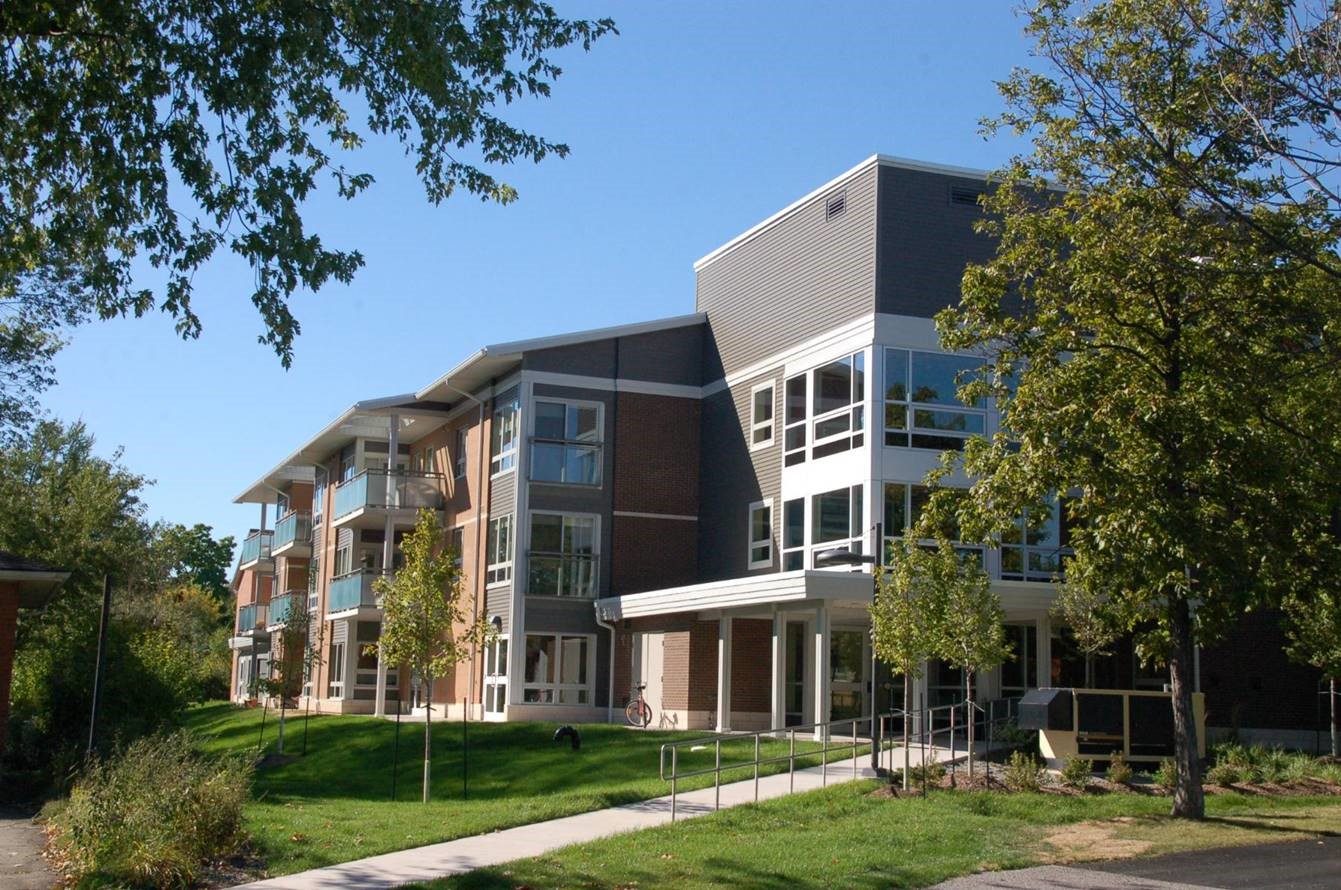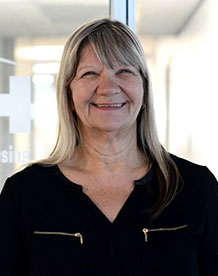Summary
Thanks to extensive consultations, astute financial management and the incorporation of energy-saving technologies, a 67-unit development in Ontario’s Niagara Region provides affordable housing for seniors, and delivers environmental and social benefits without an ongoing operating subsidy.
![]()
Project
Birchwood Place
![]()
Construction
2012–2014
![]()
Owner & Developer
Niagara Regional Housing
![]()
Cost
$9.9 million
![]()
Builder
Brouwer Construction Ltd.
![]()
Architect
Macdonald Zuberec Ensslen Architects Inc.
![]()
Affordable Housing units
23 (rent-geared-to-income)
26 affordable (80% of the average rents as published in CMHC’s annual market survey)
18 (low end of local market rates)
![]()
Funders
Province of Ontario (Municipal Affairs and Housing’s Delivering Opportunities to Ontario Renters program)
Canada Mortgage and Housing Corporation (CMHC)
Federation of Canadian Municipalities (FCM)
Context
Ontario’s Niagara region, like many regions across Canada, faces a longstanding and chronic shortage of affordable housing, particularly for seniors. Niagara Regional Housing (NRH) is responsible for community housing in the area. Governed by a Board of Directors comprised of Niagara Regional Councillors and community members, NRH provides a spectrum of low-income housing options through a combination of legislated programs and services. NRH’s current wait times for affordable housing range from 3 to 18 years, depending on the applicant’s location and requirements.
To ease the chronic shortage, NRH partnered with several funders to design and construct a financially sustainable 67-unit low-rise building. Rental rates range from rent-geared-to-income (RGI) to affordable (80% of the average rents as published in CMHC’s annual market survey) to the low end of local market rates. The project, located in Welland, also delivers a wealth of environmental and social benefits, and funds a 50-year capital reserve for the replacement of key systems and infrastructure.
Approach
NRH chose to locate the project adjacent to one of its existing buildings and to consult extensively with the 29 seniors who reside there. NRH also hosted sessions at Welland City Hall to consult with the general public, promote the project and offer assistance to interested applicants. Input from existing tenants informed several design choices, such as layouts and the inclusion of one-piece shower units (instead of bathtubs with showers).Other principles that guided the project include: universal accessibility; aging-in-place wellness model; incorporating a mix of geared-to-income and market rents; and exceeding current building-code requirements for energy by at least 40%. To ensure ongoing financial self-sufficiency, the project’s operating budget funds the replacement of all building components over their lifecycle.
“Birchwood Place demonstrates that a new community housing project can be financially self-sufficient while minimizing environmental impacts and fostering a good quality of life for residents.”
– Donna Woiceshyn, CEO, Niagara Regional Housing
Environmental Measures
- Geothermal system circulates water through underground loops and into each unit for heating and cooling. Should the system prove inadequate, tenants can activate electric heaters from the temperature controller installed in each unit.
- Regenerative-drive elevators require less energy to operate and generate less heat. When descending, the elevator’s braking mechanism powers a turbine that generates electricity to be fed back into the grid.
- Tenants collect organic waste and deposit it in bins that maintenance staff put out for curbside collection
- Rainwater collected and used for site irrigation, reducing consumption of treated water
- Low-flow water fixtures reduce consumption of treated water
- Charging station for electric vehicles encourages their use
- Green living wall in lobby improves quality of indoor air
- Smoke-free building

Fully occupied since its completion in 2014, the project earned the Region of Niagara its first LEED® Silver certification for a social housing building. The project also incorporates common areas and outdoor spaces to promote socialization and well-being. The site is adjacent to public transit and has limited parking spaces for vehicles. “The tenants love the building and are proud of the sense of community it helps to create,” says Donna Woiceshyn, CEO, Niagara Regional Housing. “They run activities such as bingo and celebrations, and decorate the common room for various holidays.”
Lessons Learned
Self-subsidization works.
Of the 67 units, 23 (34%) are rent-geared-to-income, 26 (39%) are affordable (at 80% of CMHC market rates). The market rents charged for other units, along with relatively low mortgage rates and the initial support of funders, enable the project to operate without ongoing operating subsidy.
New technologies can be more challenging and costlier to maintain than current ones.
NRH found it difficult to obtain the mechanical expertise locally needed to maintain the project’s geothermal system and regenerative-drive elevators, due to the newness of the technologies. The contractor who installed the geothermal system maintained it for the first year; NRH then found a company from nearby St. Catharines that trains its own technicians to perform ongoing maintenance work. Expertise is likely more available in larger cities and for technologies that are more established. NRH advises those considering similar projects to require that installers of key building components provide maintenance manuals and onsite staff training, and that the training be videotaped and shared with future staff.
Investments in geothermal heating and cooling systems may not generate positive returns.
The geothermal systems at Birchwood Place deliver valuable environmental benefits, including reduced greenhouse gas emissions. However, the installation and maintenance costs have negated the savings in avoided energy costs at current rates. NRH originally anticipated that these savings would cover the cost of the geothermal system within 25 years. It currently estimates that the system will at best break even over its lifecycle, as higher-than-anticipated maintenance costs reduce return on investment.
Regenerative-drive elevators can be more expensive to install and maintain than traditional models.
Higher-than-anticipated maintenance costs for the regenerative-drive elevators also reduce return on investment. NRH’s experience with the elevators and geothermal system suggests that housing providers should study in detail any new technology’s costs and benefits, paying attention to the availability of local expertise and evaluating operational costs, before deciding to use the technology.
Educate tenants about proper operation of energy-efficient equipment.
Each apartment connects to the geothermal network and has a temperature controller. Should the network fail, the tenant can use the temperature controller to activate the electric-heat backup system. Initially, some tenants activated the back-up system unnecessarily, incurring additional utility costs. Part of the problem is that the controllers are relatively complex to operate. While the tenant handbook describes how to operate the controllers properly, some tenants required additional guidance. Maintenance staff now work with each new tenant to set a heating and cooling schedule that meets their needs.
Use LEED-like principles rather than pay for certification process.
The LEED® certification process required additional costs, but provided no additional value or benefits to tenants. NRH recommends that project leads consider LEED standards instead of LEED certification.
Contact

Donna Woiceshyn
CEO, Niagara Regional Housing
905-682-9201
donna.woiceshyn@niagararegion.ca
Want to explore all GMF-funded projects? Check out the Projects Database for a complete overview of funded projects and get inspired by municipalities of all sizes, across Canada.

